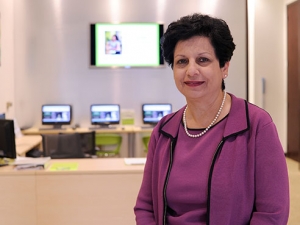Its approach to diabetes research and treatment attracted renowned scientist Anath Shalev, M.D., to UAB’s Comprehensive Diabetes Center. But it is the prospect of success outside the lab and clinic that excites her.
 |
| Anath Shalev is the new director of the UAB Comprehensive Diabetes Center, which has more than 150 faculty members dedicated to combining diabetes research, training and clinical care. |
“More than 30 percent of people in Alabama are obese, and another 30 percent are overweight,” says Shalev, the new center director and professor of medicine in the Division of Endocrinology, Diabetes and Metabolism.
UAB programs delivered directly to people throughout the state could make immediate and meaningful differences in many lives, she says.
Expansive view
Outreach is one aspect of Shalev’s expansive view of diabetes research and care. She says it is important for people to understand genetic and other factors influence the development of diabetes. “Type 1 diabetes is caused by an autoimmune process that destroys the cells in the pancreas that produce insulin, the hormone responsible for maintaining normal blood sugar. Type 2 diabetes is the result of insulin resistance, which most often is caused by obesity,” she says.
“It’s a complex disease that requires an interdisciplinary approach.”
Shalev comes to UAB from the University of Wisconsin-Madison, where she directed endocrinology, diabetes and metabolism research and conducted groundbreaking studies on cellular processes that lead to pancreatic beta-cell death associated with diabetes.
Now she heads a center with more than 150 faculty members dedicated to combining diabetes research, training and clinical care — the result of collaborative efforts involving UAB, Children’s Hospital and the Birmingham community. Shalev also is the holder of the Nancy R. and Eugene C. Gwaltney Family Endowed Chair in Juvenile Diabetes Research.
The Comprehensive Diabetes Center is only a few years old, Shalev says, so there is much work to do. In addition to innovative collaborative research, recruiting more scientific talent and expanding educational programs for the public and professionals, Shalev also wants to expand existing therapeutic options for patients.
The center is participating in a new free health center in downtown Birmingham that could help reduce diabetes levels and detect other health issues. UAB HealthSmart, located on the corner of 20th Street and Third Avenue North, offers free services such as health screenings and personalized disease-prevention programs. It’s an initiative of the UAB Minority Health & Health Disparities Research Center and the UAB Division of Preventive Medicine.
Shalev also wants to leverage opportunities available through the UAB Center for Clinical and Translational Science and capitalize on the wealth of research data produced by the UAB Division of Preventive Medicine.
“Diabetes complications will be another focus,” Shalev notes. “They take a huge toll in terms of human suffering, and treating them builds on UAB’s strengths.” She points to the UAB Multidisciplinary Comprehensive Diabetes Clinic, the only clinic in the state offering patients one-stop care from experts including ophthalmologists, neurologists, and kidney specialists.
Targeting TXNIP
“In terms of research, beta-cell biology will be one major aspect because it’s so critical for both types 1 and 2 diabetes,” says Shalev, who earned her medical degree from the University of Basel, Switzerland, and completed research fellowships at Harvard and the National Institute of Diabetes and Digestive and Kidney Diseases. The connection between beta-cell death and diabetes “has been well established, but no one knows the exact factors that are involved,” she says.
However, in conducting the first human pancreatic islet microarray study, Shalev identified thioredoxin-interacting protein (TXNIP) as an important force in diabetic beta-cell death. She later discovered that suppressing TXNIP-protected pancreatic beta cells prevented the development of both types of diabetes. “We’re convinced this is a great target,” she says.
Lowering TXNIP prevented diabetes in severely obese lab mice, which is exciting because “it means that the reduction of TXNIP could unlink obesity from diabetes,” Shalev says.
Shalev and her UAB colleagues are also keenly interested in studying the role TXNIP might play in other systemic effects of diabetes. For example, her team found significantly elevated TXNIP levels in the hearts of mice and humans with diabetes, which means that the protein may play a role in diabetic cardiomyopathy. She hopes that the research will one day lead to new drugs that could protect and promote a patient’s own beta cells while preventing or treating diabetes complications.
Dispelling diabetes myths
Myths and misconceptions about diabetes often lead people to make poor decisions based on bad information, says Anath Shalev, M.D., director of the UAB Comprehensive Diabetes Center.
Shalev says the errors are costly: Diabetes kills more people each year than breast cancer and AIDS combined. More than 25 million American children and adults live with diabetes, according to the American Diabetes Association, and the Centers for Disease Control and Prevention projects that one in three Americans will have this disease by 2050.
She identifies misconceptions about the causes of and treatment for diabetes:
Myth: Sugar or eating sweets is the cause of diabetes.
It’s not the sugar; it’s the effect of too many calories of any kind, Shalev says. Obesity is a major risk factor for Type 2 diabetes. Lack of exercise is another major contributor, especially if a sedentary lifestyle is combined with large portions of high-calorie, fatty food.
Myth: Only obese people get diabetes.
“While obesity is the strongest risk factor for Type 2 diabetes, patients with Type 1 diabetes or other less common forms often are very lean,” Shalev says. “I have seen several triathletes who are Type 1 diabetics.”
Myth: Type 1 diabetes, often called juvenile diabetes, only affects the very young.
Type 1 diabetes can affect people at any age, Shalev says, though it is more common in younger age groups. “Excessive thirst, urination and weight loss should always be warning signs to anyone of any age and warrant a doctor’s visit,” she adds.
Myth: There is no treatment for Type 2 diabetes.
Some people look at their family tree and their waistline and resign themselves to becoming diabetic. “There are people who have a constellation of genes that put them at a higher risk,” Shalev says. “But that doesn’t mean they will develop diabetes.” In most cases, Type 2 diabetes can be delayed and sometimes even prevented with adequate lifestyle modifications, including exercise and healthy diet, Shalev says. Monitoring and early intervention also are important.
Myth: Starting insulin injections in Type 2 diabetes is the beginning of the end.
Not true, Shalev says. Patients often panic and resist when told injections are necessary, but it’s the next logical step if oral medications don’t work. Shalev says emerging research suggests that starting insulin treatment early also can reduce strain on insulin-producing cells. And, the need for insulin injections is not always permanent; some patients with Type 2 diabetes eventually can stop taking insulin if they also make lifestyle changes.
Myth: Kids with diabetes can’t have anything sweet.
People with diabetes once were discouraged from having any sweets, but advances such as fast-acting insulin therapies and monitoring protocols allow for the occasional treat. A child can have a piece of birthday cake, for example, as long as they receive the proper insulin dose beforehand and are monitored closely. “It’s an intensive insulin regimen, so patients have to check more frequently, but they gain more freedom,” Shalev says.
For more information go to diabetes.dom.uab.edu.







































